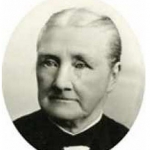Sarah Gledhill – 1868 Trail Stories
Sarah Gledhill Snow was the mother of Minnie Snow (John) Dastrup. She was born 31 Mar, 1833 in Oldham, Lancashire, England, the daughter of Edward Gledhill and Betty Hague.
Summary
About 250 emigrants, principally people from England and Scotland who crossed the Atlantic on the ship Emerald Isle, traveled in E. T. Mumford’s company. They traveled by train (in box and cattle cars) from New York to the wild and woolly end-of-track town of Benton, Wyoming (located 11 miles east of present-day Rawlins). This “Hell-on-Wheels” temporary town was inhabited by about 3,000 itinerant railroad workers, soldiers, saloon keepers, gamblers, and mule-whackers.There were twenty-five saloons and five dance halls. During its brief existence, reputedly over 100 souls met their maker in gunfights. Mumford waited there with his out-and-back teamsters for the arrival of the emigrants for nearly nine weeks. During that time several of the company’s livestock were stolen. When the emigrants arrived at the rail terminus, they loaded passengers, supplies, and luggage into a mule train of 28 wagons and started back to Utah on September 1. They traveled in a northwesterly direction from Benton through Whiskey Gap and northward from there until they reached the Sweetwater River and the old emigrant road. At this late date, they encountered head winds and cold nights. They entered the valley through Parley’s Canyon and reached Salt Lake on September 24. There were seven deaths in the company. The town in August and September 1868 provided the jumping off location for 2,000 Saints in 5 companies heading to Utah.
Following are articles and stories written by Sarah’s traveling companions:
“The Immigration,” Semi-Weekly Telegraph, 24 Sep. 1868, 2.
SATURDAY EVENING, 19.
THE IMMIGRATION.—We have been favored with a copy of the following letter to President B. Young:
ROCK CREEK, Sept. 11th, 1868.
After being detained nearly nine weeks at Benton, the last of this year’s immigration arrived, when I organized my company by appointing Elder James Smith, President of the Saints, Elder Francis A. Brown, Chaplin, and Elder Samuel Southwick, Secretary of the Company, and on the 1st of September I started homeward. During my stay at Benton I lost five animals, four horses and one mule, including my riding horse, supposed to be stolen by white men. There has occurred in the company four deaths—Sister Mary Rollinson, aged 72, of fatigue from the journey; Brother John Williams, 75 years of age, of old age; and two infants by premature birth. The health of the company is generally good.We expect to camp on the Pacific Creek to-night. We encounter much head wind, but our animals are in good heart and the feed is excellent. The nights are cold, but we make ourselves comfortable by keeping large fires and using extra clothing. I have not seen any signs of Indians as yet, and I hope to escape any dangers from them.
Allred, Isabelle Wade, [Interview], in “Utah Pioneer Biographies,” 44 vols., 3:104-5.
In 1868 father decided to quit the railroad and come to Utah. We went into Denver and there he bought a new wagon. A span of government mules and a bay mare and we came on to Salt Lake City. We traveled alone from Denver until we reached the main road for emigrants traveling from Omaha to Salt Lake City. Here we met a wagon train of emigrants under Captain [Edward T.] Mumford and we traveled along with them. Father had made money while he worked on the railroad and he had about $3000 when he came to Utah so we were well equipped. Besides the wagon and mules, we had a stove, water barrel, bedding and plenty of food. Just before we reached Green River, we were about two days travel east of there, my brother Alfred contracted mountain fever and died. We had to bury him out on the plains just beside the road without a coffin or anything. We often wished that we could locate his grave but being the route has changed some along there it would be impossible. There was also a Mrs. [Elizabeth Ketteringham] Dunn, whose folks live in Plain City now, and she died when we reached Green River. There they were able to get boards with which to make her coffin and they buried her there. In later years, the family returned and brought her body to Utah and buried it in Plain City. We go out there and visit her grave and place flowers on it in respect for my brother.
We reached Salt Lake City in October 1868 just in time for Conference

/-107.2387,41.7911,12/300x200@2x.png?access_token=pk.eyJ1IjoiamJlcmdlbiIsImEiOiJjanRxb3d1NWgwaHBuM3lvMzJ3emtyNWY4In0.xCCZGVjZrBAKn5C_O6q8CA)
/-111.891,40.7608,12/300x200@2x.png?access_token=pk.eyJ1IjoiamJlcmdlbiIsImEiOiJjanRxb3d1NWgwaHBuM3lvMzJ3emtyNWY4In0.xCCZGVjZrBAKn5C_O6q8CA)